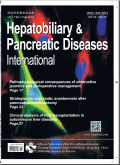- 钛学术文献服务平台 \
- 学术期刊 \
- 医药卫生期刊 \
- 内科学期刊 \
- 国际肝胆胰疾病杂志(英文版)期刊 \
Intraoperative cholangiography 2020:Quo vadis?A systematic review of the literature
Intraoperative cholangiography 2020:Quo vadis?A systematic review of the literature
基本信息来源于合作网站,原文需代理用户跳转至来源网站获取
摘要:
Background:There are few randomized controlled trials with sufficient statistical power to assess the ef-fectiveness of intraoperative cholangiography(IOC)in the detection and treatment of common bile duct injury(BDI)or retained stones during cholecystectomy.The best evidence so far regarding IOC and re-duced morbidity related to BDI and retained common bile duct stones was derived from large population-based cohort studies.Population-based studies also have the advantage of reflecting the outcome of the procedure as it is practiced in the community at large.However,the outcomes of these population-based studies are conflicting.Data sources:A systematic literature search was conducted in 2020 to search for articles that contained the terms"bile duct injury","critical view of safety","bile duct imaging"or"retained stones"in combi-nation with IOC.All identified references were screened to select population-based studies and observa-tional studies from large centers where socioeconomic or geographical selections were assumed not to cause selection bias.Results:The search revealed 273 references.A total of 30 articles fulfilled the criteria for a large obser-vational study with minimal risk for selection bias.The majority suggested that IOC reduces morbidity associated with BDI and retained common bile duct stones.In the short term,IOC increases the cost of surgery.However,this is offset by reduced costs in the long run since BDI or retained stones detected during surgery are managed immediately.Conclusions:IOC reduces morbidity associated with BDI and retained common bile duct stones.The re-ports reviewed are derived from large,unselected populations,thereby providing a high external validity.However,more studies on routine and selective IOC with well-defined outcome measures and sufficient statistical power are needed.

推荐文章
Diffusion in garnet: a review
High temperature and high pressure
Diffusion
Garnet
Point defects
"African-American Literature"的辨析与翻译
美国非裔文学
意义辨析
翻译
译文确定
A review of geoanalytical databases
Database
Geochemistry
Geology
Geoanalysis
Information system
内容分析
关键词云
关键词热度
相关文献总数
(/次)
(/年)
文献信息
| 篇名 | Intraoperative cholangiography 2020:Quo vadis?A systematic review of the literature | ||
| 来源期刊 | 国际肝胆胰疾病杂志(英文版) | 学科 | |
| 关键词 | |||
| 年,卷(期) | 2022,(2) | 所属期刊栏目 | REVIEW ARTICLES |
| 研究方向 | 页码范围 | 145-153 | |
| 页数 | 9页 | 分类号 | |
| 字数 | 语种 | 英文 | |
| DOI | |||
五维指标
引文网络
引文网络
二级参考文献 (0)
共引文献 (0)
参考文献 (0)
节点文献
引证文献 (0)
同被引文献 (0)
二级引证文献 (0)
2022(0)
- 参考文献(0)
- 二级参考文献(0)
- 引证文献(0)
- 二级引证文献(0)
引文网络交叉学科
相关学者/机构
期刊影响力
国际肝胆胰疾病杂志(英文版)
主办单位:
浙江大学医学院第一附属医院
出版周期:
双月刊
ISSN:
1499-3872
CN:
33-1391/R
开本:
大16开
出版地:
浙江省杭州市庆春路79号
邮发代号:
创刊时间:
2002
语种:
eng
出版文献量(篇)
1879
总下载数(次)
0
总被引数(次)
8662
期刊文献
相关文献
推荐文献
- 期刊分类
- 期刊(年)
- 期刊(期)
- 期刊推荐
国际肝胆胰疾病杂志(英文版)2022
国际肝胆胰疾病杂志(英文版)2021
国际肝胆胰疾病杂志(英文版)2020
国际肝胆胰疾病杂志(英文版)2019
国际肝胆胰疾病杂志(英文版)2018
国际肝胆胰疾病杂志(英文版)2017
国际肝胆胰疾病杂志(英文版)2016
国际肝胆胰疾病杂志(英文版)2015
国际肝胆胰疾病杂志(英文版)2014
国际肝胆胰疾病杂志(英文版)2013
国际肝胆胰疾病杂志(英文版)2012
国际肝胆胰疾病杂志(英文版)2011
国际肝胆胰疾病杂志(英文版)2010
国际肝胆胰疾病杂志(英文版)2009
国际肝胆胰疾病杂志(英文版)2008
国际肝胆胰疾病杂志(英文版)2007
国际肝胆胰疾病杂志(英文版)2006

 免费查重
免费查重










